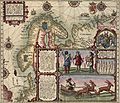Willem Barents facts for kids
Quick facts for kids
Willem Barentsz
|
|
|---|---|

Willem Barentsz
|
|
| Born | c. 1550 |
| Died | 20 June 1597 (aged c. 46) at sea
|
| Nationality | Dutch |
| Occupation | Navigator |
| Known for | Exploration of the Arctic |
Willem Barentsz (sometimes spelled Barents) was a brave Dutch explorer and navigator. He was born on the island of Terschelling around 1550. He became famous for his dangerous trips to the Arctic, trying to find a new sea route to Asia.
Willem Barentsz died at sea on June 20, 1597, near Novaya Zemlya. Many places are named after him, like the Barents Sea, Barentsburg, and the Barents Region. These names remind us of his important journeys.
Contents
Exploring the Arctic
Willem Barentsz made three big trips to the Arctic. He wanted to find a shortcut to Asia. This shortcut was called the Northeast Passage. It would let ships travel north of Europe and Asia. This was a very hard and dangerous goal.
First Voyage (1594)
Barentsz started his first trip in June 1594. He had two ships. His goal was to find the Northeast Passage. He sailed along the coast of Novaya Zemlya. This is a large island in the Arctic Ocean.
His ships reached the northern tip of Novaya Zemlya. They found open water there. This made them hopeful. But they had to turn back because of the ice. They returned to the Netherlands in September 1594.
Second Voyage (1595)
Barentsz tried again in 1595. This time, he led a fleet of six ships. They aimed to pass through the Vaygach Strait. This strait is between Novaya Zemlya and the mainland.
However, the weather was very bad. The ships faced thick fog and lots of ice. They also met polar bears. The ice made it impossible to get through the strait. The expedition had to give up. They returned home in September 1595.
Third Voyage (1596–1597)
Barentsz's third and final trip began in May 1596. This time, he had only two ships. On this journey, they discovered Spitsbergen. This is a large island in the Arctic. They also found Bear Island.
Later, one ship turned back. Barentsz continued with his own ship. They sailed east towards Novaya Zemlya. His ship got stuck in the ice in September 1596. They were trapped.
Wintering on Novaya Zemlya
Being stuck meant Barentsz and his crew had to spend the winter on Novaya Zemlya. This was a very harsh place. They built a shelter using wood from their ship. They called it Het Behouden Huys, which means "The Preserved House."
The winter was extremely cold and dark. They hunted polar bears for food. They also used the bears' fat for fuel. The crew faced many challenges. They suffered from scurvy, a serious illness.
Escape and Death
In June 1597, the ice began to break up. The crew could not free their ship. So, they decided to leave in two small boats. They hoped to reach the mainland.
Sadly, Willem Barentsz died on June 20, 1597. He passed away shortly after leaving Het Behouden Huys. His crew continued their journey. They were eventually rescued by another Dutch ship.
Legacy and Discoveries
Willem Barentsz's voyages were very important. Even though he did not find the Northeast Passage, his trips added a lot to our knowledge of the Arctic. He mapped new areas. He also provided valuable information about the Arctic climate and wildlife.
His wintering on Novaya Zemlya was a remarkable feat of survival. The remains of Het Behouden Huys were found much later. Many objects from their stay were still there. These findings showed how tough their life was.
Today, the Barents Sea is a busy area. It is important for fishing and shipping. It is named after this brave explorer. His name lives on as a symbol of courage and exploration in the frozen north.
Images for kids
See also
 In Spanish: Willem Barents para niños
In Spanish: Willem Barents para niños









